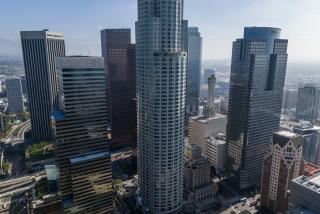Bidders Promise to Remedy the Problems at Belmont
Two competing proposals to finish the Belmont Learning Complex under a contract worth as much as $88 million both would seal off hazardous underground vapors from a former oil field and install an elaborate system of vents, air scrubbers and detectors, according to presentations made Tuesday.
Details of the two plans were made public at a board meeting of the Los Angeles Unified School District, which is expected to choose a contractor next month.
The mood at the meeting was one of cautious optimism as some board members appeared to embrace school Supt. Roy Romer’s contention that the long-delayed project could be completed within three years.
The board halted construction in 1999, midway into the project, because of environmental problems, particularly the underground gases emanating from the former oil field on which part of the school sits.
Romer said Tuesday that either of the two plans would ensure safety at the high school.
“When we have our next seismic disturbance, everybody should run [to the Belmont school] and get in the middle of this site,” Romer said. “It will be the safest place in Los Angeles to protect yourself from gases in the ground.”
The school, which would serve as many as 4,600 students, is more than 60% complete and has already cost the district $154 million. A panel of experts hired by the district estimated that it will cost an additional $68 million to $88 million to complete the school and insure the property for 30 years.
At Tuesday’s meeting, that panel did not recommend either of the bidders but stressed that both plans meet the technical and financial requirements. The two bidders will be compared in more detail over the next month.
In the school district’s original request for bids, firms were asked to cover underground trouble spots with tarp-like membranes to block pollution.
But Thierry Sanglerat, an executive at an environmental mitigation firm and a member of the Belmont review panel, said the winning contractor should construct the membrane and ventilation system under the entire 34 acres as a precautionary measure.
Whatever gases remained would be odorless and harmless, Sanglerat said.
The panel of experts also recommended that the district monitor gases at a much finer level than required by law--at least 100 times the standard mandated by the Occupational Safety and Health Administration. The estimated cost of the environmental safeguards would be $10 million to $15 million and still meet the overall budget to complete the campus and insure the district against liability.
Sanglerat noted that similar membrane and ventilation systems are in place beneath other Southern California buildings, including Hoag Memorial Hospital in Newport Beach and Cal Poly Pomona. There have been no problems there, he said.
Romer eliminated a third finalist in the bidding for the project last week because of a possible conflict of interest. Eastridge Cos. was dropped because one of its executives was involved in other real estate consulting work for the school district.
The two remaining bidders are the Alliance for a Better Community and Komex H20.
One issue the bidders failed to resolve was how to insure the site for environmental safety for the 70 years the district originally requested .
Review panel member David Dybdahl of American Risk Management Resources Network said both bidders suggested getting about 30 years of insurance coverage for about $7 million. The two firms said that there is no market for policies of 70 years.
Romer said that 30 years’ coverage and the environmental safeguards make him confident that the district will be well protected against any accidents.
More to Read
Sign up for Essential California
The most important California stories and recommendations in your inbox every morning.
You may occasionally receive promotional content from the Los Angeles Times.










